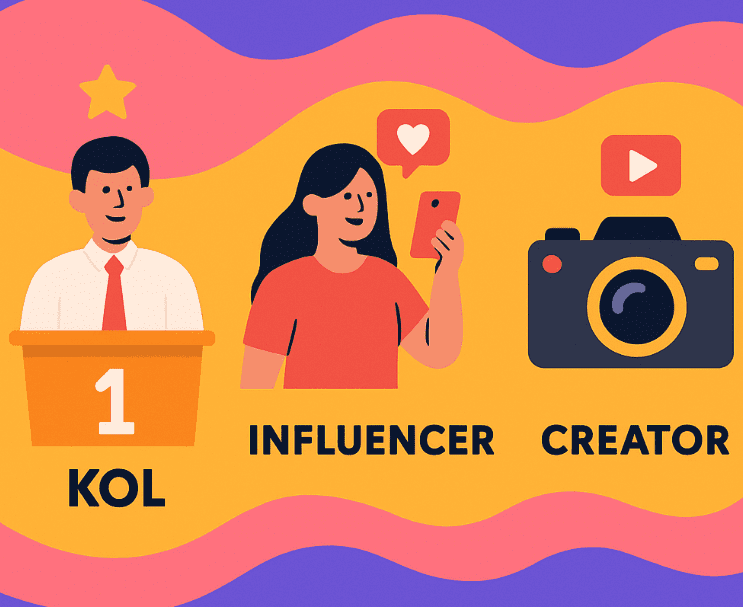In today’s diverse influencer landscape, brands in the Philippines are spoiled for choice when it comes to partnering with voices that matter. Key Opinion Leaders (KOLs), influencers, and creators are now at the center of how stories are told, products are discovered, and reputations are built.
But here’s the catch: while they’re often lumped together under the umbrella of “influencers,” their roles are actually quite different — and understanding those nuances can make or break a campaign. This is where experienced PR agencies in the Philippines often bridge external and internal messaging, helping brands choose the right partner and maximize the return on these collaborations.
Let’s break it down.
What is a KOL? Authority and Expertise First
KOLs are subject-matter experts who shape public opinion through credibility and expertise. Think of them as the go-to voices when a brand needs depth and authority.
- In the Philippine beauty space, people like Dra. Vicki Belo and Rissa Mananquil Trillo are classic KOLs. They’ve spent decades studying, influencing, and shaping the beauty industry — and their words carry weight beyond trends.
- From healthcare to finance to tech, KOLs are the professionals brands lean on for media interviews, workshops, or forums where technical or industry insights matter.
- Unlike influencers or creators, KOLs don’t need social media to establish their authority. Some are active online, yes — but their credibility stands even without a large digital following.
From a PR perspective, if your campaign requires trust and credibility, PR agencies will often recommend integrating KOLs into press conferences, product launches, or stakeholder engagements. Their presence helps brands speak with authority.
What is an Influencer? Relatability is the Currency
Influencers, unlike KOLs, primarily thrive on social media visibility. They’re skilled at building communities around lifestyle, personality, and content. Their biggest strength is relatability.
- In the Philippines, big names with tens of millions of followers are considered mega influencers, if not full-on celebrities. On the other end of the spectrum, micro-influencers speak to niche communities that feel more personal and loyal.
- Influencers may or may not have technical expertise, and that’s okay. Their role is to make products and services feel human, aspirational, or accessible. For example, a lifestyle influencer reviewing a skincare product doesn’t need to explain the science behind it. Instead, they show how it fits into their routine and what results they experienced.
From a PR perspective, influencers are perfect for campaigns where the goal is reach, engagement, and consumer relatability. PR agencies know which influencers align with your brand voice, audience demographics, and campaign goals, and they make sure these collaborations feel organic instead of transactional.
What is a Creator? Storytelling in Motion
Creators (often called UGC creators) represent a slightly different category. Their main role is content creation for brands, rather than building personal fame.
- Creators are paid not necessarily for their following, but for their creative process and output. They specialize in producing relatable and polished content — like POVs, day-in-the-life reels, or “almost forgot to mention” TikToks.
- Unlike influencers, creators often hand over their work to brands to post on official accounts. Their focus is less about personal branding, more about helping companies find fresh, authentic ways to tell stories.
- Some creators eventually transition into influencer status if their unique voice attracts followers. But many are happy staying behind the lens, collaborating closely with brands.
From a PR perspective, if you need content that blends seamlessly with your brand storytelling, creators are invaluable. A PR agency can match you with the right creators, brief them, and integrate their outputs into a broader campaign, making sure the content aligns with the brand voice and drives results.
Where They Overlap
While KOLs, influencers, and creators differ, the overlap is undeniable:
- Influence: All three drive opinions and behaviors.
- Content: They each tell stories, but in different ways and with different weights of authority.
- Community: Whether it’s an academic following, a fanbase, or a brand audience, each group commands attention.
In fact, many KOLs have turned into influencers, and some influencers are also creators. The lines blur, which is why working with a PR agency helps brands navigate the complex landscape.
Why PR Agencies Matter in the Mix
Engaging KOLs, influencers, and creators isn’t just about sending out invites or shipping free products. Done without strategy, it risks being a wasted spend or, worse, a PR misstep.
An experienced PR agency in the Philippines helps you:
- Identify the right fit — KOL, influencer, or creator — based on your objectives.
- Craft the narrative so that external and internal messaging stays aligned.
- Negotiate and manage partnerships to ensure deliverables, authenticity, and brand safety.
- Measure results not just in likes or shares, but in how they shape perception and contribute to your IMC goals.
PR is about integration. Whether it’s a thought leader in a panel, an influencer on TikTok, or a creator making UGC, the key is how their stories connect to your bigger brand voice.
You Know Which One’s Which
At the end of the day, whether you choose a KOL, influencer, or creator depends on what story you want to tell and who you want to reach. But the truth is, you don’t have to choose just one. The smartest brands integrate all three — with the guidance of a seasoned PR agency — to create campaigns that are credible, relatable, and truly unforgettable.
Contact NGP IMC for your KOL, influencer, and creator campaigns today.


